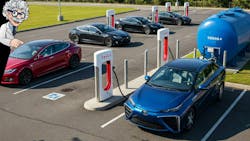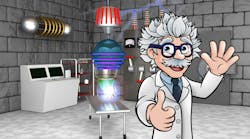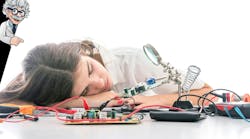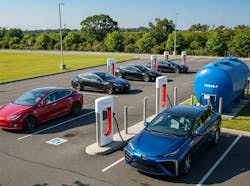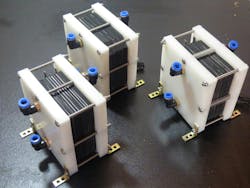Toyota Mirai FCEV Gets NACS-Based Fueling Capability
What you’ll learn:
- That “clean, nothing but water out the tailpipe” FCEV is powered by hydrogen produced by a steam-reformed methane process, which produces copious amounts of CO2, requires fresh water, and process heat (by burning more methane...).
- HHO generators, which are electrolyzers, could be used to produce sufficient hydrogen in an hour to fuel a FCEV for 312 miles with power input from a public, or Tesla, Supercharger. Really.
- The Bangkok International Motor Show 2025 runs from Wednesday, March 26, 2025, to Sunday, April 6, 2025.
- Why we have to put an explicit explanation about an April 1st article so that the search engines don’t ding us for something humorous
With journalists descending on Bangkok for the 46th annual Bangkok International Motor Show, featuring the latest concept and production cars and motorcycles, Toyoda Siam LLC (“TSL”) held an offsite, invitation-only event for American editors of automotive and engineering publications on April 1, 2025.
On a dark soi (sidestreet) off Bangkok’s main artery, Sukhumvit Road, intrepid journalists, including Electronic Design’s mostly-analog & oftentimes-automotive editor, wended their way up a rickety staircase to the 4th floor of a rent-by-the hour hotel room that was outfitted with an overhead projector and a box of Mylar “foils.” The presentation, including Q&A, would be limited to 1 hour, with an aggressive knock on the door at the 50-minute mark by some rather muscular and serious-looking hotel staff of time-enforcers.
As the humid, non-air-conditioned, 99°F room’s ceiling fans whirled, generating visible tip vortices from the thick cigarette smoke permeating the beam of the projector, TSL’s VP and General Manager, Singasong “Billy” Yordapyanoman, took the podium, welcoming everyone while dropping his first slide onto the projector. Much to everyone’s surprise, Khun Billy’s slide presentation was titled, “A Tesla NACS-based Toyota Mirai Hydrogen Fueling System.”
Hydrogen Fueling Stations Implode
“The origins of the shift from CCS to NACS can be traced back to the fall of 2022, when Tesla opened its then-proprietary standard to make the specification available to other EV manufacturers. NACS's sleeker, more compact form factor, and its ability to support charge currents of up to 1,000 A, were compelling. The driving force behind its widespread adoption may have been the potential for other manufacturers’ cars to gain access to Tesla's extensive, and rapidly expanding, national network of NACS-compatible charging stations.
As of this writing, Energy Your Way reports that Tesla currently has over 19,800 charging stations and over 73,000 individual charging points across the U.S., with over 12,800 of those in California alone. This includes over 1,000 Supercharger-equipped locations, with roughly 17,000 individual Superchargers.”— Lee Goldberg, Electronic Design
Contrast this with:
“As of 2024, there are 54 open retail hydrogen stations in the United States. Additionally, there are over 20 stations in various stages of planning or construction.”—USDOE
Hard to Cell
One of the Toyota Mirai FCEV’s (fuel-cell electric vehicle) biggest problems is the lack of fueling infrastructure. As a result, the car, despite incentives, has performed miserably in terms of sales, with only 17 cars sold in January 2025. While Toyota Japan and Toyota USA have struggled in lobbying to get hydrogen fuel infrastructure in place by hitting up the taxpayer, Toyoda Siam took a completely different approach of problem-solving, versus being a bunch of whiney babies lobbying governments worldwide to sell more fossil-fuels-based ICE (internal combustion engine) vehicles.
More April 1st Mayhem
With Toyota having been approved by, and entering into an agreement with, Tesla for NACS-based Supercharger access earlier this year, it became clear to the team at TSL that Supercharger sites were the answer to the hydrogen-fueling chicken-vs.-egg problem that their beloved Mirai (which roughly translates to “fossil-fuels Trojan Horse loser” from Japanese) was experiencing.
With a newly commissioned, NACS-capable site built in Sakon Nakhon Thailand at the town’s Vietnam-era military airfield that has dual-purpose commercial passenger service once or twice per day, Khun Billy’s engineering team was able to augment the site with the necessary equipment that enabled fueling of their FCEV, consisting of the water tank seen in Figure 1.
Tesla was told the water tank was to be installed onsite in the event of a BEV’s lithium battery fire, which seemed to be awfully common in cable-news reports, despite EV fires being 20X to 80X rarer than ICE vehicle fires. Tesla allegedly agreed to TSL’s sorta-truth and a large distilled-water tank was installed near the charging pedestals.
The next step in prototyping the system was to procure plans for a set of “HHO hydrogen generators” (these are actually electrolyzers) to be built, off Etsy, with three, assembled prototype generators shown in Figure 2.
Each “cell” was capable of producing 1 liter of hydrogen every 1.8 minutes at STP (standard temperature and pressure), with an electrical power input of 13 V at 10 A. The Mirai fuel tank stores 5 kg (55,000 liters at STP) of hydrogen, so 1,600 cells would be needed to provide sufficient hydrogen during one hour of fueling.
TSL’s researchers created a hydrolyzer (HHO generator) pack, comprised of a “box” array of 22.5 × 16 × 4 HHO cells, with the HHO “pack” dimensions being approximately 225 × 160 × 40 cm (~88.5 × 63 × 15.7480135 in.). The pack “box” would be arranged as 40s40p, requiring 520 V at 400 A (208 kW) from the supercharger to fill an empty tank inside one hour. With BEV charging times spec’d at 20% to 80%, this meant that only a 60% fill would be needed, requiring only 36 minutes for a 20/80 charge, or lowering the minimum Supercharger output requirement to 520 V at 240 A (125 kW) for a one hour 20/80 charge for compatibility with older installations.
Hold Your Water
To avoid carrying excess weight, and to avoid lithium’s highly reactive hatred for water, TSL’s researchers substituted the heavy stainless-steel plates used in YouTube and Etsy HHO generators with lithium plates that were passivated with gold via a CVD process in an abandoned semiconductor fab. Further consideration for weight meant that the distilled water needed as a feedstock would not be carried in the Mirai, but would rather use an onsite tank of distilled water—hence, the “fire extinguisher” water tank in close proximity to the Tesla chargers.
A simple garden hose quick-connect was added inside the charge-port door, next to the NACS electrical connector. The Mirai was outfitted with a 20-gallon, “reserve” distilled water tank onboard, which would permit range extension at Supercharger sites that were not equipped with distilled-water tanks.
Another problem faced by the team concerned the high-pressure storage needed for the hydrogen fuel tank, since the HHO generators produced hydrogen at atmospheric pressures. Here, they developed a constant-current-mode, two-stage compressor also running off the electrical power being supplied through the NACS connector from the Supercharger.
With the NACS-based fueling system, Toyoda Siam LLC believes the FCEV now has a future in mobility—Toyota marketing no longer needing to greenwash the fact that 97% of hydrogen used by the Mirai FCEV today is produced by steam reforming methane...fracking-derived methane. Now Toyota’s little FCEV can run directly from solar and wind renewables, completely gutting methane as a fuel source. The company’s multinational divisions are now in Zoom meetings in an effort to gain approval to rebadge the car from Mirai to Avril-1 (“April Fuels”).
The Bangkok International Motor Show 2025 runs from Wednesday, March 26, 2025 - Sunday, April 6, 2025. Really.
AndyT's Nonlinearities blog arrives the first and third Monday of every month. To make sure you don't miss the latest edition, new articles, or breaking news coverage, please subscribe to our Electronic Design Today newsletter. Please also subscribe to Andy’s Automotive Electronics bi-weekly newsletter.
More April 1st Articles
About the Author
Andy Turudic
Technology Editor, Electronic Design
Andy Turudic is a Technology Editor for Electronic Design Magazine, primarily covering Analog and Mixed-Signal circuits and devices. He holds a Bachelor's in EE from the University of Windsor (Ontario Canada) and has been involved in electronics, semiconductors, and gearhead stuff, for a bit over a half century.
"AndyT" brings his multidisciplinary engineering experience from companies that include National Semiconductor (now Texas Instruments), Altera (Intel), Agere, Zarlink, TriQuint,(now Qorvo), SW Bell (managing a research team at Bellcore, Bell Labs and Rockwell Science Center), Bell-Northern Research, and Northern Telecom and brings publisher employment experience as a paperboy for The Oshawa Times.
After hours, when he's not working on the latest invention to add to his portfolio of 16 issued US patents, he's lending advice and experience to the electric vehicle conversion community from his mountain lair in the Pacific Northwet[sic].
AndyT's engineering blog, "Nonlinearities," publishes the 1st and 3rd monday of each month. Andy's OpEd may appear at other times, with fair warning given by the Vu meter pic.
